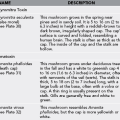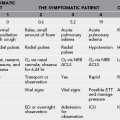Shock
Disorders
Box 13-1 outlines the types of shock.
Signs and Symptoms
Treatment
1. Keep the patient lying supine. If the patient experiences dyspnea because of heart failure and pulmonary edema, raise the shoulders or, if tolerated, support in a sitting position.
2. Elevate the legs only if bleeding is controlled and there is no concern for spinal cord injury. This may transiently improve cardiac output in noncardiogenic shock.
a. You can elevate the legs by allowing the patient to recline with the feet uphill.
b. If the patient has internal bleeding, avoid any unnecessary movement.
c. With pulmonary edema, the patient may be more comfortable with the head and shoulders raised slightly.
3. Do not elevate the patient’s legs if there is a severe head injury, difficulty breathing, a broken leg, neck or back injury, uncontrolled bleeding, or if doing so causes pain.
4. Keep the patient covered and warm. Particularly try to keep the patient’s head, neck, and hands covered. Take the patient out of harsh weather conditions, and insulate from the ground. If you cannot locate sufficient covering for warmth, lie next to the patient and share body heat.
5. Attempt to control external bleeding with direct pressure. If that is not successful, a tourniquet(s) may become necessary.
6. Loosen restrictive clothing.
7. Splint all fractures. If the femur is fractured, apply and maintain traction (see Chapter 18). Apply a pelvic sling for suspected pelvic fractures (see Chapter 12).
8. Administer intravenous (IV) fluid resuscitation.
a. This is not recommended in suspected cardiogenic shock because fluid administration may cause worsening heart failure and pulmonary edema.
b. Insert a large-gauge IV catheter (preferably 18 to 14 gauge), and administer initially 1 to 2 L normal saline or lactated Ringer’s solution for adults. For children administer 20 mL/kg IV over 10 to 20 minutes and repeat as necessary every 30 to 60 minutes, up to 60 mL/kg.
c. If transport to a medical center will take longer than 6 hours and the patient is likely suffering from noncardiogenic shock, you may attempt oral fluid resuscitation as tolerated. The patient should not be given oral fluids if he or she has altered mental status or is vomiting.
9. Do not administer oral fluids to a patient with suspected intra-abdominal or thoracic hemorrhage.
10. Administer high-flow oxygen (10 to 15 L/min by face mask) if available.
11. For septic shock, start early empiric antibiotic coverage for suspected organisms. Combination therapy directed at gram-positive, gram-negative, and anaerobic organisms may be indicated for unknown or multiple sites of infection. All initial antibiotics in septic shock should be administered intravenously if possible. The following are examples of combination therapy in adults:
• Ceftriaxone 1 g IV over 3 to 5 minutes PLUS clindamycin 600 to 900 mg IV
• Metronidazole 500 mg IV over 1 hour OR ciprofloxacin 400 mg IV; PLUS clindamycin 600 to 900 mg IV
12. For massive soft tissue damage or open fracture, administer a cephalosporin (e.g., cefazolin 1 g IV) over 3 to 5 minutes. Oral fluoroquinolones (e.g., ciprofloxacin 500 mg) can be given orally if IV cephalosporins are unavailable.
13. In a diabetic patient, consider hypoglycemia (see Chapter 29). If the patient is conscious and can swallow adequately, administer glucose paste or a sugar-sweetened liquid in small sips. Otherwise, do not give the patient anything to eat or drink unless he or she is alert and hungry or thirsty.
14. If the patient appears to be suffering from an allergic reaction to a bite or sting (see Chapters 26 and 38), address the cause of that reaction.
15. Because patients suffering from shock cannot be effectively diagnosed and treated in the field, transport them to a medical facility as quickly as possible.






